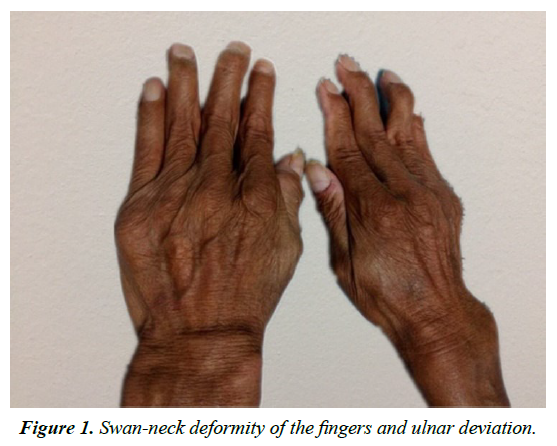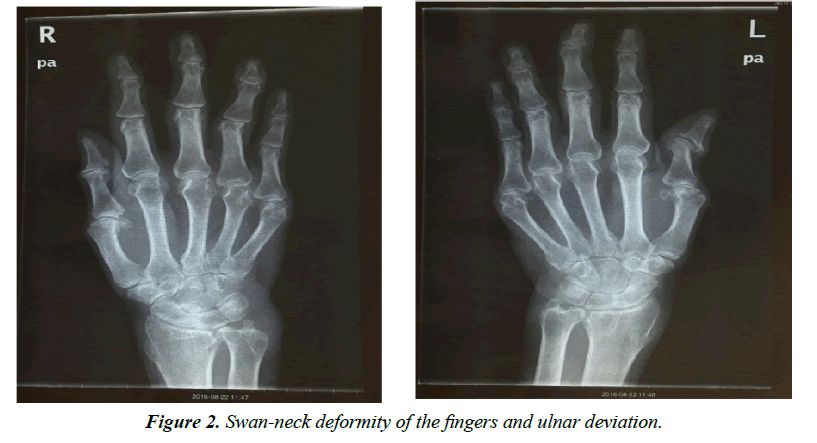Case Report - Virology Research Journal (2017) Virology Research Journal (Special Issue 2-2017)
Jaccoud's arthropathy in primary biliary cirrhosis
Fang Ji and Xuebing Yan*Department of Infectious Diseases, The Affiliated Hospital of Xuzhou Medical University, Jiangsu, P.R. China
- Corresponding Author:
- Xuebing Yan
Department of Infectious Diseases
The Affiliated Hosipital of Xuzhou Medical College 9
9 Huai hai West Road Xuzhou
Jiangsu, 221002
P.R. China
Tel: 0086-516-85803622
E-mail: jifang800410@foxmail.com
Accepted Date: July 29, 2017
Citation: Ji F, Yan X. Jaccoud’s arthropathy in primary biliary cirrhosis. Virol Res J. 2017;1(2):3-5.
Abstract
Jaccoud’s arthropathy (JA) is a deforming arthropathy, nowadays present mostly in systemic lupus erythematosus (SLE). Primary biliary cirrhosis (PBC), which predominantly affects middle-aged women, is histologically characterized by chronic non-suppurative destructive cholangitis. The chief target of PBC is the liver. We describe a rare case of PBC with hand deformities typical of JA.
Introduction
Primary biliary cirrhosis (PBC) is a chronic progressive cholestatic liver disease with fibrosis leading to cirrhosis [1–3] and liver failure [4,5]. PBC is often thought of as an organ-specific autoimmune disease, which mainly targets the liver; however, other tissue also can be a site for autoimmune involvement of PBC. Jaccoud’s arthropathy (JA) was a nonerosive deforming arthropathy initially described in patients with rheumatic fever (RF). Presently, the majority of the cases are seen in systemic lupus erythematosus (SLE) [6-8]. Whereas, this complication is associated with other clinical conditions.
Case Report
We report this case to discuss the relationship between PBC and JA.
A 57-year- old man was referred to us for assessment of a 2-year history of ascites. During past two years, he had experienced repeated abdominal effusion and jaundice, and an abdominal ultrasound scan showed liver cirrhosis. Because of severe abdominal distension, he was hospitalized at our institution. The patient presented that his hands and feet deformed since nine years ago. At the age of 30 he had acute painless joint swelling of both hands which lasted for one week. Then he felt episodic stiffness of hands but did not notice the deformities until nine years ago. During the course, there were no recurrent fever and pain. Having received a diagnosis of rheumatoid arthritis, the patient once was treated with non-steroid antiinflammatory drugs (NSAIDs) and prednisone several months but not receive improvement of the deformities. He reported no consumption of alcohol. On physical examination, the patient was without fever and had normal blood pressure. We did not identify abnormalities during the cardiorespiratory evaluation. On abdominal examination, we identified shifting dullness but no hepatosplenomegaly. The patient had swan-neck deformity of the fingers, slightly ulnar deviation of metacarpal bones and comparatively obvious ulnar deviation of right phalanxes. (Figure 1). The function of his hands was limited and the deformities were partly reversible. The X-ray of the hands showed the deformities of the metacarpophalangeal (MCP) and interphalangeal joints, normal joint space and no bone erosion (Figure 2). Meanwhile, there were degenerative changes of the joints. Laboratory tests results indicated haemoglobin of 10.5
Discussion and Conclusion
PBC is an important cause of liver cirrhosis and endstage liver disease [2]. It has 4 histologic stages: (1) portal inflammation with or without florid bile duct lesions; (2) increase in size of periportal lesions with interface hepatitis; (3) distortion of hepatic architecture with numerous fibrous septa; and (4) cirrhosis [9]. Our patient belonged to stage 4. Both genetic and environmental triggers have been considered important for the induction of PBC, as well as other autoimmune diseases [10-12]. Many reports indicate that PBC, as a kind of autoimmune liver diseases (AILD), is related to other autoimmune diseases, such as Sjogren’s syndrome (SS), systemic lupus erythematosus (SLE), systemic sclerosis (SSc), rheumatoid arthritis (RA), dermatomyositis and so on [13]. However, there was no described case of JA associated with PBC. Jaccoud's arthropathy is a syndrome characterized by progressive, painless and nonerosive deformity mainly affecting the joints of hands and feet. But a limitation on the study of JA is the lack of definite diagnostic or classification criteria. The previous studies demonstrate that the classical JA include the presence of ‘‘reversible deformities’’ and absence of erosions on X-rays and rheumatoid factor negativity [14] or as ‘‘any deviation of the metacarpus finger axes assessed by a goniometer’’ [15]. Basing on these clinical features, Spronk et al. [16] developed a diagnostic ‘‘index’’ which allowed for the presence of different deformities and attributing JA a score of over five points. Our patient presented the features of JA. The mechanisms responsible for development of JA are not yet well defined. Persistent synovitis and fibrotic retraction of the joint capsule are the mechanisms involved in the development of JA [17]. It was unknown if PBC leaded to JA in our patient. Because the pathogenesis of two diseases maybe involves autoimmune and environmental factors [3,6,7], PBC and JA in our case possibly were caused by the common factors.
References
- Hohenester S, Oude-Elferink RPJ, Beuers U. Primary biliary cirrhosis. Seminars in Immunopathology. 2009;31: 283-307.
- Kaplan MM, Gershwin ME. Primary biliary cirrhosis. N Engl J Med. 2005;353:1261-1273.
- Neuberger J. Primary biliary cirrhosis. The Lancet. 1997;350: 875-879.
- Heathcote EJ. Management of primary biliary cirrhosis. Hepatology.2000;31:1005-1013.
- Poupon R. Primary biliary cirrhosis: a 2010 update. J Hepatol. 2010;52:745-758.
- Skare TL, Godoi AL, Ferreira VO. Jaccoudarthropathy in systemic lupus erythematosus:clinical and serological findings. Rev Assoc Med Bras. 2012;58:489-492.
- Ahmadi-Simab K, Lamprecht P, Gross WL. Jaccoud-Arthritis beisystemischem Lupus erythematodes. ZeitschriftfürRheumatologie. 2005; 64:343-344.
- Santiago MB, Galvão V, Ribeiro DS, et al. Severe Jaccoud’sarthropathy in systemic lupuserythematosus. Rheumatol Int. 2015;35:1773-77.
- Imam MH, Lindor KD. The natural history of primary biliary cirrhosis. Semin Liver Dis. 2014; 34(3):329-33.
- Miller FW, Pollard KM, Parks CG, et al. Criteria for environmentally associated autoimmune diseases. JAutoimmun. 2012; 39:253-258.
- Smyk DS, Rigopoulou EI, Bogdanos DP. Potential roles for infectious agents in the pathophysiology of primary biliary cirrhosis: What's new? Curr Infect Dis Rep 2013;15:14-24.
- Purohit, T. Primary biliary cirrhosis: Pathophysiology, clinical presentation and therapy. World J Hepatol, 2015. 7: 926-941.
- Czaja AJ. Autoimmune liver disease and rheumatic manifestations. CurrOpin Rheumatol.2007; 19 (1): 74-80.
- Bywaters EG (1950) The relation between heart and joint disease including ‘‘rheumatoid heart disease’’ and chronic post rheumatic arthritis (type Jaccoud). Br Heart J 12:101–131.
- Alarcon-Segovia D, Abud-Mendoza C, Diaz-Jouanen E, et al. Deforming arthropathy of the hands in systemic lupus erythematosus. JRheumatol 15:65–69.
- Spronk PE, ter Borg EJ, Kallenberg CG (1992) Patients with systemic lupus erythematosus and Jaccoud’sarthropathy: a clinical subset with an increased C reactive protein response? Ann Rheum Dis 51:358–361.
- Paredes JG, Lazaro MA, Citera G, Da Representacao S, Maldonado Cocco JA. Jaccoud’sarthropathy of the hands in overlap syndrome. ClinRheumatol. 1997;16:65–69.

